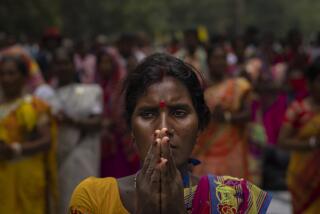Jain Ascetics Give It All Up for Their Faith
- Share via
NEW DELHI — Dressed in a coarse white cotton sari, her hair shorn and a small piece of white cloth covering her mouth, Sadika Sansiddhi looks nothing like other 17-year-olds.
Two years ago, she left the comfort of her middle class home to become a nun in the ancient Jain religion practiced by more than 4 million people in India.
Her parents and grandparents opposed her decision. They are Jains, and believe in the small daily sacrifices the religion demands. But they wanted to spare Sadika the deprivation and hardship she was choosing. Eventually, after two years of demands, beginning when she was just 13, they relented.
Along with 15 other nuns, Sadika now lives in a rundown building in a crowded neighborhood in New Delhi, India’s capital. They sleep on bare concrete floors, spend long hours in meditation and read religious texts. “Ahimsa,” or nonviolence, guides their lives, and much of what they do is dictated by their efforts to kill no living thing, not even insects.
Only a tiny percentage of Jains have chosen Sadika’s uncompromising path. But as India joins the global economy, the ascetics have become one of the most powerful symbols of an older, less materialistic, India.
In a booming India of consumers earning hefty salaries, where towns are sprouting glitzy shopping malls, discos and restaurants, the Jain ascetics stick out for their self-denying ways and simple lifestyles: They beg for food; they travel by foot; they practice celibacy.
“You have to restrict your wants and desires to reach a higher spiritual level,” said chubby-faced Sadika, sounding much older than a teenager.
Jainism, similar in its asceticism and monastic discipline to Buddhism, originated in India around 500 B.C.
Like Hindus, Jains believe in reincarnation. But whereas Hindus believe all souls are part of a universal spirit, Jains believe in an independent soul reincarnated in pursuit of an ultimate state of happiness.
Salvation is obtained by personal effort -- leading austere, nonviolent lives.
Jains take extraordinary measures to avoid killing any living creature.
Groups of ascetics are often seen walking along roads, sweeping the ground before them with a soft cotton brush to make sure they do not step on insects.
Some, like Sadika, wear face masks to make sure they don’t accidentally breathe them in.
Over the centuries, the Jains split into two sects over the propriety of going naked. Swetambers wear white unstitched robes, whereas Digambers -- or “sky-clad” -- wear nothing at all.
“We’ve given up everything -- money, wealth, family. If we had to wear clothes, we’d have to beg for money. That is an obligation we can do without,” said Muni Shiv Sagar, a 46-year-old Jain sadhu, sitting naked on a raised wooden platform to spare his audience any embarrassment.
A wooden water bottle and a fan are his only possessions.
A meal consists of one handful of grain --”just enough to stay alive,” he said.
He travels, he said, on foot only, walking for weeks at a time along ancient routes, sleeping in temples or the homes of Jain families.
If that lifestyle sounds harsh, the ascetics see it as liberating. “Wealth is a burden, which you pass on to others when you die,” Acharya Darshan Sagar Maharaj, 57, a senior Digamber Jain priest, told a group of believers in New Delhi one recent morning.
“This insatiable quest for wealth and power is the underlying evil behind all the world’s ills,” the naked priest, revered as a saint, told the clothed devotees sitting cross-legged on the bare floor.
In fact, some Jains have no problem at all with wealth. Its lay believers are one of India’s richest communities, long known for their business acumen, diligence, honesty and reputation as considerate employers.
“Why are Jains successful in business? In three words -- it’s humility, humanity and hard work,” said Anil Jain, a tax consultant to numerous wealthy clients.
“We don’t drink, don’t smoke, eat only vegetarian food, don’t go to clubs or night spots. Even the younger generation of Jains don’t get too many opportunities to spend money,” he said.
Lay believers are free to marry, earn money and live in comfort. Affluent Jains justify their earnings by contributing to charities and the upkeep of temples and the clergy. Profits are plowed back into the business after contributions to charity and temples.
“As businessmen, if we earn money, we put it to good use. Everyone has his or her own way of practicing their belief -- whether it’s feeding the poor, running charity hospitals, taking care of birds or maintaining temples,” said Sukhanand Jain, who owns a wholesale pharmaceutical business and whose family has extensive real estate holdings in New Delhi.
But his family leads a simple life.
Like the majority of Jains, his family members are strict vegetarians and teetotalers who eat just two meals a day. They don’t eat after sunset, worried the lights will attract insects that could accidentally be swallowed while eating.
More to Read
Sign up for Essential California
The most important California stories and recommendations in your inbox every morning.
You may occasionally receive promotional content from the Los Angeles Times.












